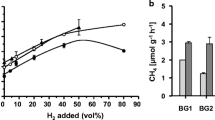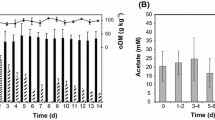Abstract
Pool sizes of short-chain fatty acids (formate, acetate, propionate, and butyrate), hydrogen, and carbon monoxide were assayed in digesting sludge from four different methanogenic reactors degrading either sewage sludge or agricultural products and wastes at pH 8.0 and 40 or 47 °C. Free reaction energies were calculated for the respective degradation reactions involved, indicating that acetate, propionate, and butyrate degradation all supplied sufficient energy (−10 to −30 kJ per mol reaction) to sustain the microbial communities involved in the respective processes. Pools of formate and hydrogen were energetically equivalent as electron carriers. In the sewage sludge reactor, homoacetogenic acetate formation from H2 and CO2 was energetically feasible whereas syntrophic acetate oxidation appeared to be possible in two biogas reactors, one operating at enhanced ammonia content (4.5 g NH4 +-N per l) and the other one at enhanced temperature (47 °C). Maximum capacities for production of methanogenic substrates did not exceed the consumption capacities by hydrogenotrophic and aceticlastic methanogens. Nonetheless, the capacity for acetate degradation appeared to be a limiting factor especially in the reactor operating at enhanced ammonia concentration.
Similar content being viewed by others
References
Adams CJ, Redmond MC, Valentine DL (2006) Pure-culture growth of fermentative bacteria, facilitated by H2 removal: bioenergetics and H2 production. Appl Environ Microbiol 72(2):1079–1085
Ahring BK, Sandberg M, Angelidaki I (1995) Volatile fatty acids as indicators of process imbalance in anaerobic digestors. Appl Microbiol Biotechnol 43(3):559–565
Amend JP, Shock EL (2001) Energetics of overall metabolic reactions of thermophilic and hyperthermophilic Archaea and bacteria. FEMS Microbiol Rev 25(2):175–243
Batstone DJ, Pind PF, Angelidaki I (2003) Kinetics of thermophilic, anaerobic oxidation of straight and branched chain butyrate and valerate. Biotechnol Bioeng 84(2):195–204
Bryant M, Wolin E, Wolin M, Wolfe R (1967) Methanobacillus omelianskii, a symbiotic association of two species of bacteria. Arch Mikrobiol 59(1–3):20–31
Buswell A, Mueller H (1952) Mechanism of methane fermentation. Industrial & Engineering Chemistry 44(3):550–552
Can M, Armstrong FA, Ragsdale SW (2014) Structure, function, and mechanism of the nickel metalloenzymes, CO dehydrogenase, and acetyl-CoA synthase. Chem Rev 114(8):4149–4174
Conrad R, Wetter B (1990) Influence of temperature on energetics of hydrogen metabolism in homoacetogenic, methanogenic, and other anaerobic bacteria. Arch Microbiol 155(1):94–98
Dwyer DF, Weeg-Aerssens E, Shelton DR, Tiedje JM (1988) Bioenergetic conditions of butyrate metabolism by a syntrophic, anaerobic bacterium in coculture with hydrogen-oxidizing methanogenic and sulfidogenic bacteria. Appl Environ Microbiol 54(6):1354–1359
Fey A, Conrad R (2000) Effect of temperature on carbon and electron flow and on the archaeal community in methanogenic rice field soil. Appl Environ Microbiol 66(11):4790–4797
Gujer W, Zehnder A (1983) Conversion processes in anaerobic digestion. Water Science & Technology 15(8–9):127–167
Hao L-P, Lü F, He P-J, Li L, Shao L-M (2010) Predominant contribution of syntrophic acetate oxidation to thermophilic methane formation at high acetate concentrations. Environmental Science & Technology 45(2):508–513
Ho DP, Jensen PD, Batstone DJ (2013) Methanosarcinaceae and acetate-oxidizing pathways dominate in high-rate thermophilic anaerobic digestion of waste-activated sludge. Appl Environ Microbiol 79(20):6491–6500
Hoehler TM, Alperin MJ, Albert DB, Martens CS (2001) Apparent minimum free energy requirements for methanogenic Archaea and sulfate-reducing bacteria in an anoxic marine sediment. FEMS Microbiol Ecol 38(1):33–41
Kaspar HF, Wuhrmann K (1978) Kinetic parameters and relative turnovers of some important catabolic reactions in digesting sludge. Appl Environ Microbiol 36(1):1–7
Krylova NI, Conrad R (1998) Thermodynamics of propionate degradation in methanogenic paddy soil. FEMS Microbiol Ecol 26(4):281–288
Lim JK, Mayer F, Kang SG, Müller V (2014) Energy conservation by oxidation of formate to carbon dioxide and hydrogen via a sodium ion current in a hyperthermophilic archaeon. Proc Natl Acad Sci 111(31):11497–11502
Lü F, Hao L, Guan D, Qi Y, Shao L, He P (2013) Synergetic stress of acids and ammonium on the shift in the methanogenic pathways during thermophilic anaerobic digestion of organics. Water Res 47(7):2297–2306
McCarty PL, Smith DP (1986) Anaerobic Waste-Water Treatment. 4. Environmental Science & Technology 20(12):1200–1206. doi:10.1021/es00154a002
McInerney MJ, Bryant MP, Pfennig N (1979) Anaerobic bacterium that degrades fatty acids in syntrophic association with methanogens. Arch Microbiol 122(2):129–135
Moestedt J, Nordell E, Schnürer A (2014) Comparison of operating strategies for increased biogas production from thin stillage. J Biotechnol 175:22–30
Müller N, Schleheck D, Schink B (2009) Involvement of NADH: acceptor oxidoreductase and butyryl coenzyme A dehydrogenase in reversed electron transport during syntrophic butyrate oxidation by Syntrophomonas wolfei. J Bacteriol 191(19):6167–6177
Müller N, Worm P, Schink B, Stams AJ, Plugge CM (2010) Syntrophic butyrate and propionate oxidation processes: from genomes to reaction mechanisms. Environ Microbiol Rep 2(4):489–499
Müller V (2015) Microbial life at the thermodynamic limit: how much energy is required to sustain life? Environ Microbiol Rep 7(1):31–32
Nationale Akademie der Wissenschaften Leopoldina (2012) Bioenergie: Möglichkeiten und Grenzen. Halle (Saale) Online unter: http://wwwleopoldinaorg/uploads/tx_leopublication/201207_Empfehlungen_Bioenergie_02pdf
Noike T, Endo G, Chang JE, Yaguchi JI, Matsumoto JI (1985) Characteristics of carbohydrate degradation and the rate-limiting step in anaerobic digestion. Biotechnol Bioeng 27(10):1482–1489
Palatsi J, Viñas M, Guivernau M, Fernandez B, Flotats X (2011) Anaerobic digestion of slaughterhouse waste: main process limitations and microbial community interactions. Bioresour Technol 102(3):2219–2227
Pauss A, Samson R, Guiot S (1990) Thermodynamic evidence of trophic microniches in methanogenic granular sludge-bed reactors. Appl Microbiol Biotechnol 33(1):88–92
Penning H, Conrad R (2006) Effect of inhibition of acetoclastic methanogenesis on growth of archaeal populations in an anoxic model environment. Appl Environ Microbiol 72(1):178–184
Ragsdale SW, Pierce E (2008) Acetogenesis and the Wood–Ljungdahl pathway of CO2 fixation. Biochimica et Biophysica Acta (BBA)-Proteins and Proteomics 1784(12):1873–1898
Schink B (1997) Energetics of syntrophic cooperation in methanogenic degradation. Microbiol Mol Biol Rev 61(2):262–280
Schink B, Stams AJ (2013) Syntrophism among prokaryotes. In: Rosenberg E, DeLong EF, Lory S, Stackebrandt E, Thompson F (eds) The prokaryotes - prokaryotic communitites and ecophysiology, 4th edn. Springer, Berlin Heidelberg, pp 471–493
Schmidt A, Müller N, Schink B, Schleheck D (2013) A proteomic view at the biochemistry of syntrophic butyrate oxidation in Syntrophomonas wolfei. PLoS One 8(2):e56905
Schnürer A, Houwen FP, Svensson BH (1994) Mesophilic syntrophic acetate oxidation during methane formation by a triculture at high ammonium concentration. Arch Microbiol 162(1–2):70–74
Schnürer A, Schink B, Svensson BH (1996) Clostridium ultunense sp. nov., a mesophilic bacterium oxidizing acetate in syntrophic association with a hydrogenotrophic methanogenic bacterium. Int J Syst Bacteriol 46(4):1145–1152
Schnürer A, Svensson BH, Schink B (1997) Enzyme activities in and energetics of acetate metabolism by the mesophilic syntrophically acetate-oxidizing anaerobe Clostridium ultunense. FEMS Microbiol Lett 154(2):331–336
Scholten JC, Conrad R (2000) Energetics of syntrophic propionate oxidation in defined batch and chemostat cocultures. Appl Environ Microbiol 66(7):2934–2942
Schuchmann K, Müller V (2014) Autotrophy at the thermodynamic limit of life: a model for energy conservation in acetogenic bacteria. Nat Rev Microbiol 12:809–821
Seiler W, Giehl H, Roggendorf P (1980) Detection of carbon monoxide and hydrogen by conversion of mercury oxide to mercury vapor. Atmos Technol, United States, p. 12
Seitz H-J, Schink B, Pfennig N, Conrad R (1990) Energetics of syntrophic ethanol oxidation in defined chemostat cocultures. Arch Microbiol 155(1):82–88
Spahn S, Brandt K, Müller V (2015) A low phosphorylation potential in the acetogen Acetobacterium woodii reflects its lifestyle at the thermodynamic edge of life. Arch Microbiol 197:745–751
Thauer RK, Jungermann K, Decker K (1977) Energy conservation in chemotrophic anaerobic bacteria. Bacteriol Rev 41(1):100
Wang J, Liu H, Fu B, Xu K, Chen J (2013) Trophic link between syntrophic acetogens and homoacetogens during the anaerobic acidogenic fermentation of sewage sludge. Biochem Eng J 70:1–8
Worm P, Fermoso FG, Stams AJ, Lens PN, Plugge CM (2011) Transcription of fdh and hyd in Syntrophobacter spp. and Methanospirillum spp. as a diagnostic tool for monitoring anaerobic sludge deprived of molybdenum, tungsten and selenium. Environ Microbiol 13(5):1228–1235
Zinder SH, Koch M (1984) Non-aceticlastic methanogenesis from acetate: acetate oxidation by a thermophilic syntrophic coculture. Arch Microbiol 138(3):263–272
Acknowledgments
The authors are grateful to Melanie Hecht, Thomas Dickhaus, and Sarah Refai for organizing the sampling campaigns at the biogas reactors at Troisdorf and to Erich Kronenthaler and Martin Kaspar for the supply of sewage sludge and operation parameters of the reactor at the wastewater treatment plant in Konstanz. The technical help with specific experiments in the lab by Antje Wiese, Ye Schmidt, and Stefan Bieletzki is highly appreciated.
Author information
Authors and Affiliations
Corresponding author
Ethics declarations
Funding
This study was funded by the German Federal Ministry for Education and Research, project BioPara, project number 03SF0421E.
Conflict of interest
The authors declare that they have no competing interests.
Ethical approval
This article does not contain any studies with human participants or animals performed by any of the authors.
Electronic supplementary material
ESM 1
(PDF 437 kb)
Rights and permissions
About this article
Cite this article
Montag, D., Schink, B. Biogas process parameters—energetics and kinetics of secondary fermentations in methanogenic biomass degradation. Appl Microbiol Biotechnol 100, 1019–1026 (2016). https://doi.org/10.1007/s00253-015-7069-0
Received:
Revised:
Accepted:
Published:
Issue Date:
DOI: https://doi.org/10.1007/s00253-015-7069-0




